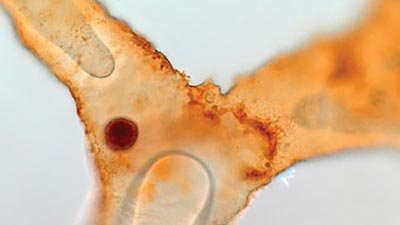Ireland's Sea Dragon
BBC News: “River reveals ‘Jurassic dragon’” Fossilized vertebrae previously belonging to a “sea monster” have been uncovered in Northern Ireland in a “chance in a million” discovery, reports the BBC.
Found in Colin Glen, an area described by park ranger Paul Bennett as “rich in fossils and [...] of great geological interest,” the 2 3/4-inch (7 cm) section of backbone is from a plesiosaur said to have lived more than 144 million years ago and possibly as long as 190 million years ago. (The substantially divergent dates are not explained in the article, nor is any information given on how the age estimates were deduced.)
Plesiosaurs, which Bennett notes could grow to some 20 m (66 ft) long, were long-necked, small-headed creatures that swam using four flippers.
Plesiosaurs, which Bennett notes could grow to some 20 m (66 ft) long, were long-necked, small-headed creatures that swam using four flippers. Their sharp teeth and snapping jaws have helped characterize them as menacing aquatic predators, thus the christening of the creature as a “sea monster” or “Jurassic dragon.”
The existence of modern-day plesiosaurs, presumably hiding in such places as the ocean deep and even Loch Ness, is sometimes discussed in creationist circles. A living plesiosaur would certainly be a surprise to secular science, which considers them to have gone extinct with the dinosaurs (although plesiosaurs were not actually dinosaurs, but aquatic reptiles). A carcass reeled in by the Japanese fishing trawler Zuiyo-maru in 1977 was for years the object of plesiosaur-centric speculation, but the carcass was in all likelihood the remains of a basking shark (based on detailed analysis). For these reasons, we recommend against creationists using the story as evidence for extant plesiosaurs.
But while living plesiosaurs have not been found, many “living fossils” have been found, including the coelacanth, a fish previously declared by secular science to have been extinct for 65 million years, based on the fossil record. (Although the tune quickly changed when a live coelacanth was found in 1938!) Furthermore, if plesiosaurs were around even several hundred years ago, they could help account for the tales of sea monsters shared in most seafaring cultures (and mentioned in the Bible; Job 41:31 describes Leviathan as “mak[ing] the sea like a pot of ointment”).
For more information:
Remember, if you see a news story that might merit some attention, let us know about it! (Note: if the story originates from the Associated Press, Fox News, MSNBC, the New York Times, or another major national media outlet, we will most likely have already heard about it.) And thanks to all of our readers who have submitted great news tips to us.
(Please note that links will take you directly to the source. Answers in Genesis is not responsible for content on the websites to which we refer. For more information, please see our Privacy Policy.)
Recommended Resources

Answers in Genesis is an apologetics ministry, dedicated to helping Christians defend their faith and proclaim the good news of Jesus Christ.
- Customer Service 800.778.3390
- Available Monday–Friday | 9 AM–5 PM ET
- © 2026 Answers in Genesis





